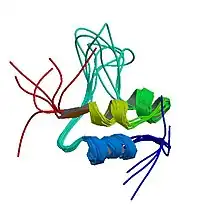| Doege–Potter syndrome | |
|---|---|
 | |
| The structure of IGF-2, responsible for the hypoglycemia associated with Doege–Potter syndrome | |
| Specialty | Oncology |
Doege–Potter syndrome (DPS) is a paraneoplastic syndrome[1] in which hypoglycemia is associated with solitary fibrous tumors. The hypoglycemia is the result of the tumors producing insulin-like growth factor 2.[2] The syndrome was first described in 1930, by Karl Walter Doege (1867–1932), a German-American physician[3] and by Roy Pilling Potter (1879–1968), an American radiologist, working independently;[4] the full term Doege–Potter syndrome was infrequently used until the publication of a 2000 article[5] using the eponym.[6]
DPS is rare (as of 1976, less than one hundred cases were described[7]), with a malignancy rate of 12–15%. Actual rates of hypoglycemia associated with a fibrous tumor are quite rare (a 1981 study of 360 solitary fibrous tumors of the lungs found that only 4% caused hypoglycemia[8]), and are linked to large tumors with high rates of mitosis.[9] Removal of the tumor will normally resolve the symptoms.[1][9]
Tumors causing DPS tend to be quite large;[10] in one case a 3 kg (6.6 lb), 23×21×12 cm (9.1×8.3×4.7 in) mass was removed, sufficiently large to cause a collapsed lung.[5] In X-rays, they appear as a single mass with visible, defined borders, appearing at the edges of the lungs or a fissure dividing the lobes of the lungs.[10] Similar hypoglycemic effects have been related to mesenchymal tumors.[6]
References
- 1 2 Balduyck B, Lauwers P, Govaert K, Hendriks J, De Maeseneer M, Van Schil P (July 2006). "Solitary fibrous tumor of the pleura with associated hypoglycemia: Doege–Potter syndrome: a case report". J Thorac Oncol. 1 (6): 588–90. doi:10.1097/01243894-200607000-00016. PMID 17409923.
- ↑ Herrmann BL, Saller B, Kiess W, et al. (2000). "Primary malignant fibrous histiocytoma of the lung: IGF-II producing tumor induces fasting hypoglycemia". Exp. Clin. Endocrinol. Diabetes. 108 (8): 515–18. doi:10.1055/s-2000-11007. PMID 11149628.
- ↑ Doege, KW (1930). "Fibrosarcoma of the mediastinum". Ann Surg. 92 (5): 955–960. PMC 1398259. PMID 17866430.
- ↑ Roy M, Burns MV, Overly DJ, Curd BT (November 1992). "Solitary fibrous tumor of the pleura with hypoglycemia: the Doege–Potter syndrome". J Ky Med Assoc. 90 (11): 557–60. PMID 1474302.
- 1 2 Chamberlain MH, Taggart DP (January 2000). "Solitary fibrous tumor associated with hypoglycemia: an example of the Doege–Potter syndrome". J. Thorac. Cardiovasc. Surg. 119 (1): 185–7. doi:10.1016/S0022-5223(00)70242-X. PMID 10612786. Archived from the original on 2013-01-12.
- 1 2 Shields, TW; LoCicero J; Ponn RB; Rusch VW (2005). General thoracic surgery. Hagerstwon, MD: Lippincott Williams & Wilkins. pp. 893. ISBN 0-7817-3889-X.
- ↑ Ellorhaoui M, Graf B (February 1976). "[Intrathoracal tumor with accompanying hypoglycemia]". Z Gesamte Inn Med (in German). 31 (3): 77–81. PMID 785836.
- ↑ Briselli M, Mark EJ, Dickersin GR (June 1981). "Solitary fibrous tumors of the pleura: eight new cases and review of 360 cases in the literature". Cancer. 47 (11): 2678–89. doi:10.1002/1097-0142(19810601)47:11<2678::AID-CNCR2820471126>3.0.CO;2-9. PMID 7260861.
- 1 2 Zafar H, Takimoto CH, Weiss G (2003). "Doege–Potter syndrome: hypoglycemia associated with malignant solitary fibrous tumor". Med. Oncol. 20 (4): 403–08. doi:10.1385/MO:20:4:403. PMID 14716039.
- 1 2 Light, Richard J. (2007). Pleural diseases. Hagerstwon, MD: Lippincott Williams & Wilkins. pp. 172–3. ISBN 978-0-7817-6957-0.